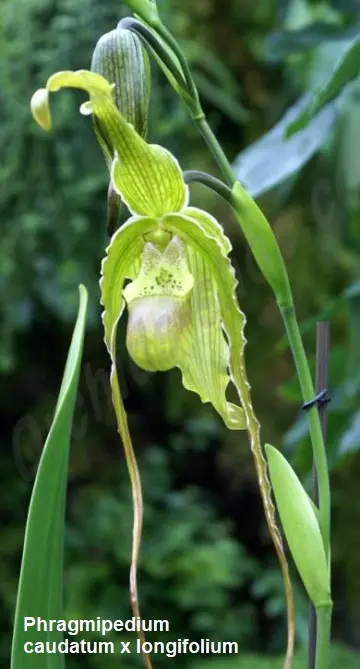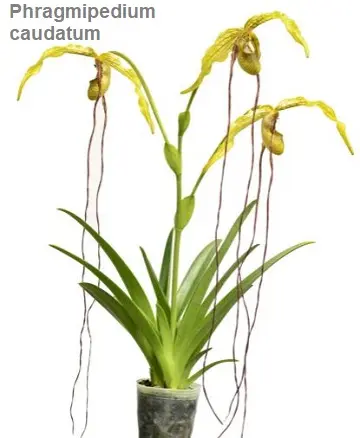 |
||
| Phragmipedium
The ladies slipper (Paphiopedilum)of the americas, this genus of 21 species is distributed from Mexico down to Brazil. They can be ephiphytes, but are more commonly lithophytes or even terrestial. They prefer intermediate conditions with plenty of water all year round. |
||
| Phragmipedium caudatum x longifolium its here |
||
| /\ Top of Page | ||
 |
||
| Phragmipedium
The ladies slipper (Paphiopedilum)of the americas, this genus of 21 species is distributed from Mexico down to Brazil. They can be ephiphytes, but are more commonly lithophytes or even terrestial. They prefer intermediate conditions with plenty of water all year round. |
||
| Phragmipedium caudatum | ||
| /\ Top of Page | ||
 |
||
| Phragmipedium
The ladies slipper (Paphiopedilum)of the americas, this genus of 21 species is distributed from Mexico down to Brazil. They can be ephiphytes, but are more commonly lithophytes or even terrestial. They prefer intermediate conditions with plenty of water all year round. |
||
| phragmipedium kovachii | ||
| /\ Top of Page | ||
 |
||
| Podangis A single species confined to the equitorial rain forest of Africa from Guinea across to Tanzania. This dwarf ephiphyte has fan like leave system and from the base of which the inflorescences arise. They require a warm and humid environment |
||
| Podangis dactiloceras | ||
| /\ Top of Page | ||
 |
||
| Promenaea A genus of 14 species from Brazil. Ephiphytes, these plants live in the moist forests. Their pseudobulbs are covered by a sheath from which the flowers emerge. Grow under intermediate conditions and water all year round. |
||
| Promenaea citrata x limelight | ||
| /\ Top of Page | ||
 |
||
| Promenaea A genus of 14 species from Brazil. Ephiphytes, these plants live in the moist forests. Their pseudobulbs are covered by a sheath from which the flowers emerge. Grow under intermediate conditions and water all year round. |
||
| Promenaea guttata | ||
| /\ Top of Page | ||
 |
||
| Promenaea A genus of 14 species from Brazil. Ephiphytes, these plants live in the moist forests. Their pseudobulbs are covered by a sheath from which the flowers emerge. Grow under intermediate conditions and water all year round. |
||
| Promenaea rollinsonii | ||
| /\ Top of Page | ||
 |
||
| Promenaea A genus of 14 species from Brazil. Ephiphytes, these plants live in the moist forests. Their pseudobulbs are covered by a sheath from which the flowers emerge. Grow under intermediate conditions and water all year round. |
||
| Promenaea meadown gold x xanthina | ||
| /\ Top of Page | ||
 |
||
| Psychopsis There are 4 species, found in Costa Rica and Peru. The name means butterfly like and these unifoliate ephiphytes are found in the moist forest canopy. They are quite easy to grow in intermediate to warm conditions. |
||
| Psychopsis kramerianum | ||
| /\ Top of Page | ||
 |
||
| Robiquetia Found in tha Asian tropics, this genus has 40 species. Monopodal in nature, these ephiphytes have a long netctar spurs on densely flowered racemes. They should be kept in warm conditions, with plenty of water and can be grown in pots or baskets. |
||
| Robiquetia cerina | ||
| /\ Top of Page | ||
 |
||
| Robiquetia Found in tha Asian tropics, this genus has 40 species. Monopodal in nature, these ephiphytes have a long netctar spurs on densely flowered racemes. They should be kept in warm conditions, with plenty of water and can be grown in pots or baskets. |
||
| Robiquetia spathulata | ||
| /\ Top of Page | ||
 |
||
| Saccolabium Under review, but around 350 species in this genus but many are synonym for other genera and several are unplaced. They are found in tropical Asia. |
||
| Saccolabium quisumbingii | ||
| /\ Top of Page | ||
 |
||
| Sarcochilus From Australasia, ther are 14 species in this genus. Most are small monopodal ephiphytes with long lasting colourful flowers that are often fragrant. They prefer bright light and intermediate conditions. |
||
| Sarcochilus fitzgeraldii | ||
| /\ Top of Page | ||
 |
||
| Sigmatostalix A genus of 35 species distributed from Mexico to Brazil. The plants are epiphytes from the very wet forest regions and are easy to cultivate under intermediate conditions, either in pots or mounted. |
||
| Sigmatostalix radicans | ||
| /\ Top of Page | ||
 |
||
| Sobralia
A genus of some 95 species, it is distributed throughout tropical America. Characterised by canelike stems and thin veined leaves the inflorences appear at the leaf axils. The plants are epiphytes or terrestials growing on embankments in the wet forests. |
||
| Sobralia machranta | ||
| /\ Top of Page | ||
 |
||
| Spathoglottis
A genus of 40 species distributed through Southern India to China and as far south as New Caledonia. These plants are deciduous and the flowers rise from the base of the pseudobulb wihich has grasslike leaves. |
||
| Spathoglottis aurea | ||
| /\ Top of Page | ||
 |
||
| Spathoglottis
A genus of 40 species distributed through Southern India to China and as far south as New Caledonia. These plants are deciduous and the flowers rise from the base of the pseudobulb wihich has grasslike leaves. |
||
| Spathoglottis kimballiana | ||
| /\ Top of Page | ||
 |
||
| Stanhopea
A genus of 55 species distributed from Mexico to Brazil. The epiphytes have oval dark green pseudobulbs with a single heavily veined leaf. The inflorecence is produced from the base of the bulb and hang down in a pendant fashion. |
||
| Stanhopea sp | ||
| /\ Top of Page | ||